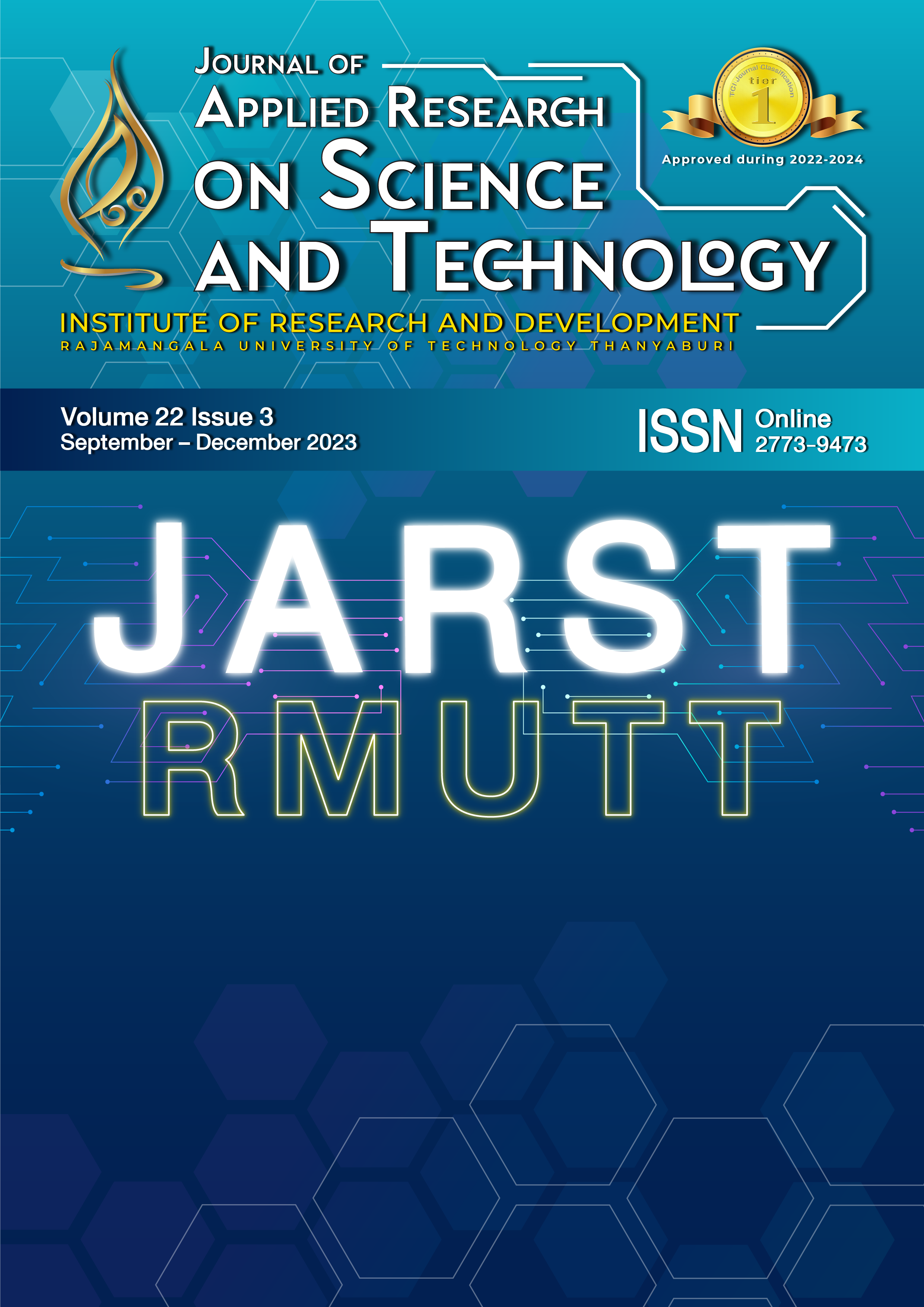2-Keto-gluconate production and purification by thermotolerant acetic acid bacterium Nguyenibacter vanlangensis KKS-R1
Main Article Content
Abstract
2-Keto-gluconic acid (2-KGA) is a pivotal intermediate in the production process of ascorbic acid, commonly known as vitamin C. The bacterium Nguyenibacter vanlangensis KKS-R1 is an acetic acid bacterium (AAB) that has been selectively screened for its ability to produce 2-KGA among twenty-five bacterial isolates at high temperatures up to 40°C. This thermotolerant property makes it advantageous for various industries. Therefore, it has garnered interest for its potential application in the production of 2-KGA and purification of the 2-KGA product. This study evaluated the production of 2-KGA by N. vanlangensis KKS-R1 using 1% gluconate as the substrate. The 2-KGA was determined by thin-layer chromatography, Lanning and Cohen’s method, and high-performance liquid chromatography. After fermentation in a minimal liquid medium for 24 hours, the bacterium showcased its prowess by producing 2-KGA concentrations of 7.5 g/L. However, the purity of the 2-KGA production is paramount for industrial applications. In addressing this, a rigorous chromatographic purification regimen was employed. This involved two sequential stages of ion exchange chromatography, DEAE-Sephacel and DOWEX 1X4, followed by SuperdexTM S-200 column chromatography. The collective efficacy of these methodologies yielded a product with an impressive purity index of 71.02%. The 2-KGA product was then subjected to a decolorization process using activated carbon and freeze-dried. This results in the compound being a pure white powder. This investigation indicates that N. vanlangensis KKS-R1 shows good potential as a 2-KGA producer at high temperatures. Under proper purification techniques. These findings contribute to developing purified processes and producing 2-KGA for industrial efficiency.
Article Details

This work is licensed under a Creative Commons Attribution-NonCommercial-NoDerivatives 4.0 International License.
References
Sievers M, Ludwig W, Teuber M. Phylogenetic positioning of Acetobacter, Gluconobacter, Rhodopila and Acidiphilium species as a branch of acidophilic bacteria in the α-subclass of Proteobacteria based on 16S ribosomal DNA sequences. Syst Appl Microbiol. 1994;17(2):189-96.
Trček J, Mira NP, Jarboe LR. Adaptation and tolerance of bacteria against acetic acid. Appl Microbiol Biotechnol. 2015;99(15):6215-29.
Sengun I, Karabiyikli S. Importance of acetic acid bacteria in the food industry. Food Control. 2011;22:647-56.
Wang B, Shao Y, Chen F. Overview on mechanisms of acetic acid resistance in acetic acid bacteria. World J Microbiol Biotechnol. 2015;31.
Matsushita K, Toyama H, Adachi O. Respiratory chains and bioenergetics of acetic acid bacteria. In Rose AH, Tempest DW, editors. Advanced in Microbial Physiology. 36: Academic Press; 1994. p. 247-301.
Adachi O, Ano Y, Toyama H, Matsushita K. Biooxidation with PQQ-and FAD-dependent dehydrogenases. In Schmid RD, Urlacher V, editors. Modern Biooxidation: Enzyme, Reactions and Application. Wiley; 2007. p. 1-41.
Sun L, Wang DM, Sun WJ, Cui FJ, Gong JS, Zhang XM, et al. Two-stage semi-continuous 2-keto-gluconic acid (2KGA) production by Pseudomonas plecoglossicida JUIM01 from rice starch hydrolyzate. Front Bioeng Biotechnol. 2020;8:120.
Walker R. Erythorbic acid and its sodium salt. Joint FAO/WHO expert committee on food additives (JEFCA), Toxicological evaluation of certain food additives and contaminants Geneva: World Health Organization. 1991:27-60.
Wei Z, Yu S, Sun W, Zhou Q, Li Z. Research progress on fermentation production of 2-keto-D-gluconic acid. Food Sci. 2008;29:636-9.
Shinagawa E, Ano Y, Yakushi T, Adachi O, Matsushita K. Solubilization, purification, and properties of membrane-bound D-glucono-delta-lactone hydrolase from Gluconobacter oxydans. Biosci Biotechnol Biochem. 2009;73(1):241-4.
Matsushita K, Shinagawa E, Ameyama M. D-Gluconate dehydrogenase from bacteria, 2-keto-D-gluconate-yielding, membrane-bound. Methods Enzymol. 89: Academic Press; 1982. p. 187-93.
Shinagawa E, Matsushita K, Adachi O, Ameyama M. D-Gluconate dehydrogenase, 2-keto-D-gluconate yielding, from Gluconobacter dioxyacetonicus: purification and characterization. Agric Biol Chem. 1984;48(6):1517-22.
Matsushita K, Fujii Y, Ano Y, Toyama H, Shinjoh M, Tomiyama N, et al. 5-keto-D-gluconate production is catalyzed by a quinoprotein glycerol dehydrogenase, major polyol dehydrogenase, in Gluconobacter species. Appl Environ Microbiol. 2003;69(4):1959-66.
Shinagawa E, Matsushita K, Adachi O, Ameyama M. Purification and characterization of 2-keto-D-gluconate dehydrogenase from Gluconobacter melanogenus. Agric Biol Chem. 1981;45(5):1079-85.
Ubonrat J, Somporn M, Nongpanga K, Duangtip M. Isolation and screening of plant growth promoting bacteria (PGPB) from rice (Oryza sativa) and rhizosphere soil. Prog Appl Sci Technol. 2018;8(2):190-204.
DeMoss RD. Preparation and determination of gluconic, 2-ketogluconic, and 5-ketogluconic acids. Methods in Enzymology. 3: Academic Press; 1957. p. 232-238.
Juechan S, Lorliam W, Sukontasing S, Moonmangmee S, Moonmangmee D. A novel exopolysaccharides from nitrogen fixing acetic acid bacterium, Nguyenibacter vanlangensis AR-R3. J Appl Res Sci Technol. 2022;21(2):1-13.
Dulley JR, Grieve PA. A simple technique for eliminating interference by detergents in the Lowry method of protein determination. Anal Biochem. 1975;64(1):136-41.
Perumpuli PABN, Watanabe T, Toyama H. Pellicle of thermotolerant Acetobacter pasteurianus strains: characterization of the polysaccharides and of the induction patterns. J Biosci Bioeng. 2014;118(2):134-8.
Purkait MK, Gusain DS, DasGupta S, De S. Adsorption behavior of chrysoidine dye on activated charcoal and its regeneration characteristics by using different surfactants. Separation Sci Technol. 2005;39(10):2419-40.


